 W
WBritish Library, Add MS 40618 is a late 8th century illuminated Irish Gospel Book with 10th century Anglo-Saxon additions. The manuscript contains a portion of the Gospel of Matthew, the majority of the Gospel of Mark and the entirety of the Gospels of Luke and John. There are three surviving Evangelist portraits, one original and two 10th century replacements, along with 10th century decorated initials. It is catalogued as number 40618 in the Additional manuscripts collection at the British Library.
 W
WThe Sherborne Missal is an early 15th-century English illuminated manuscript missal, one of the finest English examples of International Gothic painting. With 347 vellum leaves measuring 535 by 380 millimetres, it weighs 20 kg. It has survived in excellent condition, and is usually on display at the Ritblat Gallery in the British Library. It has been described as "beyond question the most spectacular service book of English execution to have come down to us from the later Middle Ages."
 W
WThe Anthony Roll is a paper record of ships of the English Tudor navy of the 1540s, named after its creator, Anthony Anthony. It originally consisted of three rolls of vellum, depicting 58 naval vessels along with information on their size, crew, armament, and basic equipment. The rolls were presented to King Henry VIII in 1546, and were kept in the royal library. In 1680 King Charles II gave two of the rolls to Samuel Pepys, who had them cut up and bound as a single volume book, which is now in the Pepys Library at Magdalene College, Cambridge. The third roll remained in the royal collection until it was given by King William IV to his daughter Lady Mary Fox, who sold it to the British Museum in 1858; it is now owned by the British Library.
 W
WThe Bedford Hours is a French late medieval book of hours. It dates to the early fifteenth century (c. 1410–30); some of its miniatures, including the portraits of the Duke and Duchess of Bedford, have been attributed to the Bedford Master and his workshop in Paris. The Duke and Duchess of Bedford gave the book to their nephew Henry VI in 1430. It is in the British Library, catalogued as Add MS 18850.
 W
WThe Benedictional of St. Æthelwold is a 10th-century illuminated benedictional, the most important surviving work of the Anglo-Saxon Winchester School of illumination. It contains the various pontifical blessings used during Mass on the differing days of the ecclesiastical year along with a form for blessing the candles used during the Feast of the Purification. The manuscript was written by the monk Godeman at the request of Æthelwold, Bishop of Winchester.
 W
WThe Bodmin manumissions are records included in a manuscript Gospel book, the Bodmin Gospels or St Petroc Gospels, British Library, Add MS 9381. The manuscript is mostly in Latin, but with elements in Old English and the earliest written examples of the Cornish language, which is thus of particular interest to language scholars and early Cornish historians. The manuscript was discovered by Thomas Rodd, a London bookseller and it was sold to the British Museum by Rodd in May 1833. It is thought to have been made in Brittany - now part of France - and dates from the last quarter of the 9th century to 1st quarter of the 11th century.
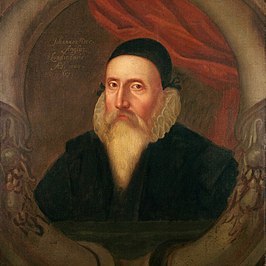 W
WThe Book of Soyga, also titled Aldaraia, is a 16th-century Latin treatise on magic, one copy of which was owned by the Elizabethan scholar John Dee. After Dee's death, the book was thought lost until 1994, when two manuscripts were located in the British Library and the Bodleian Library, under the title Aldaraia sive Soyga vocor, by Dee scholar Deborah Harkness. The Sloane MS 8 version is also described as Tractatus Astrologico Magicus, though both versions differ only slightly.
 W
WAdd MS 29987 is a medieval Tuscan musical manuscript dating from the late fourteenth or early fifteenth century, held in the British Library in London. It contains a number of polyphonic Italian Trecento madrigals, ballate, sacred mass movements, and motets, and 15 untexted monophonic instrumental dances, which are among the earliest purely instrumental pieces in the Western musical tradition. The manuscript apparently belonged to the de' Medici family in the fifteenth century, and by 1670 was in the possession of Carlo di Tommaso Strozzi; it was in the British Museum from 1876, where it was catalogued as item 29987 of the Additional manuscripts series. It is now in the British Library.
 W
WBritish Library, Add MS 11848 is an illuminated Carolingian Latin Gospel Book produced at Tours. It contains the Vulgate translation of the four Gospels written on vellum in Carolingian minuscule with Square and Rustic Capitals and Uncials as display scripts. The manuscript has 219 extant folios which measure approximately 330 by 230 mm. The text is written in area of about 205 by 127 mm. In addition to the text of the Gospels, the manuscript contains the letter of St. Jerome to Pope Damasus and of Eusebius of Caesarea to Carpian, along with the Eusebian canon tables. There are prologues and capitula lists before each Gospel. A table of readings for the year was added, probably between 1675 and 1749, to the end of the volume. This is followed by a list of capitula incipits and a word grid which were added in the Carolingian period.
 W
WThe Ceolfrid Bible is a fragment of a late 7th or early 8th century Bible. It is almost certainly a portion of one of the three single-volume Bibles ordered made by Ceolfrid, Abbot of Monkwearmouth-Jarrow. It is closely related to the Codex Amiatinus, which is the only surviving complete Bible of the three ordered by Ceolfrid. The eleven surviving vellum leaves of the manuscript contain portions of the Latin Vulgate text of the third and fourth Books of Kings.
 W
WThe Codex Beneventanus is an 8th-century illuminated codex containing a Gospel Book. According to a subscription on folio 239 verso, the manuscript was written by a monk named Lupus for one Ato, who was probably Ato, abbot (736–760) of the monastery of San Vincenzo al Volturno, near Benevento. The unusual odd number of Canon Tables suggests these seven folios were prepared as much as two centuries earlier than the rest of the codex.
 W
WCodex Nitriensis, designated by R or 027, ε 22, is a 6th-century Greek New Testament codex containing the Gospel of Luke, in a fragmentary condition. It is a two column manuscript in majuscules, measuring 29.5 cm by 23.5 cm.
 W
WCodex Sinaiticus or "Sinai Bible" is one of the four great uncial codices, ancient, handwritten copies of a Christian Bible in Greek. The codex is a historical treasure.
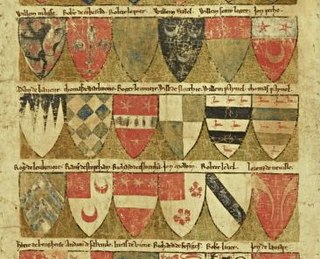 W
WThe Dering Roll is the oldest English roll of arms surviving in its original form. It was made between 1270 and 1280 and contains the coat of arms of 324 knights, starting with two illegitimate children of King John. Sir Edward Dering acquired the roll during the 17th century and modified it to include a fictitious ancestor of his own. It was eventually purchased by the British Library following fund raising involving a number of other charities and individuals.
 W
WThe Eadwine Psalter or Eadwin Psalter is a heavily illuminated 12th-century psalter named after the scribe Eadwine, a monk of Christ Church, Canterbury, who was perhaps the "project manager" for the large and exceptional book. The manuscript belongs to Trinity College, Cambridge and is kept in the Wren Library. It contains the Book of Psalms in three languages: three versions in Latin, with Old English and Anglo-Norman translations, and has been called the most ambitious manuscript produced in England in the twelfth century. As far as the images are concerned, most of the book is an adapted copy, using a more contemporary style, of the Carolingian Utrecht Psalter, which was at Canterbury for a period in the Middle Ages. There is also a very famous full-page miniature showing Eadwine at work, which is highly unusual and possibly a self-portrait.
 W
WThe Golden Haggadah is an illuminated manuscript originating around c. 1320-1330 in the region of Catalonia. It is an example of an Illustrated Haggadah, a religious text for Jewish Passover. It contains many lavish illustrations in the High Gothic style with Italianate influence, and is perhaps one of the most distinguished illustrated manuscripts created in Spain. The Golden Haggadah currently resides in the British Library and can be fully viewed as part of their Digitized Manuscript Collection MS 27210.
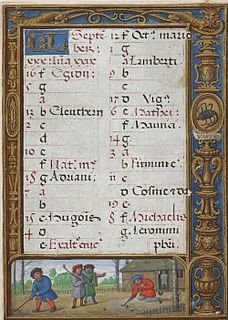 W
WThe Golf Book is the common name for an illuminated manuscript Book of Hours in the Use of Rome dating from the 1540s. Only 23 pages remain of the original created by the illuminator Simon Bening and his studio in Bruges. It owes its popular name to one illustration in the calendar, with people playing a game resembling that of golf. It is presumed to have been made for a Swiss patron as the book includes a miniature painting of St Boniface of Lausanne.
 W
WThe Gorleston Psalter is a 14th-century manuscript notable for containing early music instruction and for its humorous marginalia. It is named for the town of Gorleston in Norfolk.
 W
WThe Gospels of Tsar Ivan Alexander, Tetraevangelia of Ivan Alexander, or Four Gospels of Ivan Alexander is an illuminated manuscript Gospel Book, written and illustrated in 1355–1356 for Tsar Ivan Alexander of the Second Bulgarian Empire. The manuscript is regarded as one of the most important manuscripts of medieval Bulgarian culture, and has been described as "the most celebrated work of art produced in Bulgaria before it fell to the Turks in 1393".
 W
WThe Holkham Bible is an illustrated collection of biblical and apocryphal stories in Norman French. It was produced in England during the decades before 1350 for use by an unidentified Dominican friar. The illustrations depict the stories in contemporary English settings, making it a visual source on medieval English society. Previously part of the library of Holkham Hall, Norfolk, the Holkham Bible is now held by the British Library.
 W
WThe Hours of Joanna I of Castile is a sixteenth-century illuminated codex housed in the British Library, London, under shelfmark Add MS 35313.
 W
WThe Hours of Louis XII was an illuminated manuscript book of hours produced by Jean Bourdichon for Louis XII of France. It was begun in 1498 or 1499, going by the king's age of 36 given below his portrait; he became king on 7 April 1498. The book reached England, where it was broken up around 1700. Now only parts of it survive – in total sixteen full-page miniature paintings, two sheets of text and fifty-one sheets of text bound in the wrong order as a thin volume.
 W
WThe Hours of Saint-Omer is an illuminated book of hours produced in Northern France for the use of Marguerite de Beaujeu around 1320-1330. It follows the Arras liturgy. The manuscript gains its name from the fact that its calendar gives special attention to the church and the relics of Saint Omer in the town of Saint-Omer.
 W
WThe London Canon Tables is a Byzantine illuminated Gospel Book fragment on vellum from the sixth or seventh century. It was possibly made in Constantinople. The fragment consists of two folios of two illuminated canon tables – of unusual construction – set beneath an ornamental arcade and the Letter by Eusebius of Caesarea which usually prefaces canon tables. The fragment is bound together with a twelfth-century Gospel Book which is thought to have belonged to one of the monasteries on Mount Athos.
 W
WThe Luttrell Psalter is an illuminated psalter commissioned by Sir Geoffrey Luttrell (1276–1345), lord of the manor of Irnham in Lincolnshire, written and illustrated on parchment circa 1320–1340 in England by anonymous scribes and artists.
 W
WMinuscule 699, δ104, is a Greek minuscule manuscript of the New Testament, on parchment. Palaeographically it has been assigned to the 11th century. Some leaves of the manuscript were lost. Scrivener labelled it by 603e.
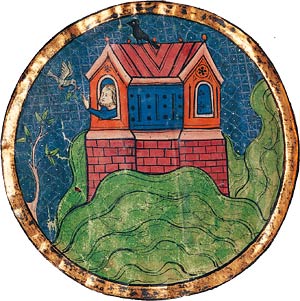 W
WThe North French Hebrew Miscellany or "French Miscellany" or "London Miscellany" is an important Hebrew illuminated manuscript from 13th-century France, created c. 1278-98. A miscellany is a manuscript containing texts of different types and by different authors, and this volume contains a wide range of Hebrew language texts, mostly religious but many secular. The manuscript is exceptional among medieval Hebrew manuscripts both for its size and the diversity of the texts and the quality and lavishness of its illuminations, which as was often the case were added by Christian specialists.
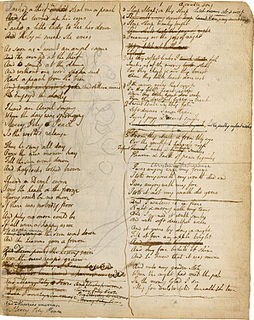 W
WThe Notebook of William Blake was used by William Blake as a commonplace book from c. 1787 to 1818.
 W
WThe Robertsbridge Codex (1360) is a music manuscript of the 14th century. It contains the earliest surviving music written specifically for keyboard.
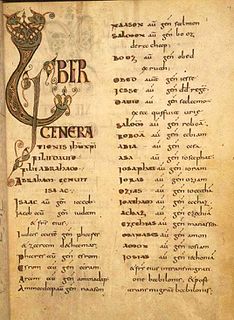 W
WThe Schuttern Gospels is an early 9th century illuminated Gospel Book that was produced at Schuttern Abbey in Baden. According to a colophon on folio 206v, the manuscript was written by the deacon Liutharius, at the order of his abbot, Bertricus.
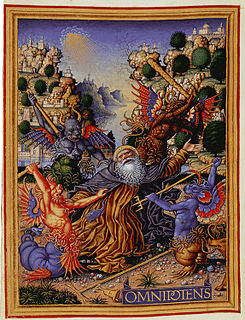 W
WThe Sforza Hours, is a richly illuminated book of hours initiated by Bona Sforza, widow of Galeazzo Sforza, Duke of Milan, around 1490, who commissioned the illuminator Giovanni Pietro Birago. The book remained in an unfinished state for 30 years until Margaret of Austria, Regent of the Netherlands, commissioned its completion in 1517–20 from the artist Gerard Horenbout. The book therefore contains decoration of the highest quality by two artists. It provides a unique example of an early sixteenth-century Northern Renaissance illuminator's response to Milanese art of the late Quattrocento. The history of the Sforza Hours also includes one of the earliest recorded examples of art theft.
 W
WThe Sherborne Missal is an early 15th-century English illuminated manuscript missal, one of the finest English examples of International Gothic painting. With 347 vellum leaves measuring 535 by 380 millimetres, it weighs 20 kg. It has survived in excellent condition, and is usually on display at the Ritblat Gallery in the British Library. It has been described as "beyond question the most spectacular service book of English execution to have come down to us from the later Middle Ages."
 W
WThe St Cuthbert Gospel, also known as the Stonyhurst Gospel or the St Cuthbert Gospel of St John, is an early 8th-century pocket gospel book, written in Latin. Its finely decorated leather binding is the earliest known Western bookbinding to survive, and both the 94 vellum folios and the binding are in outstanding condition for a book of this age. With a page size of only 138 by 92 millimetres, the St Cuthbert Gospel is one of the smallest surviving Anglo-Saxon manuscripts. The essentially undecorated text is the Gospel of John in Latin, written in a script that has been regarded as a model of elegant simplicity.
 W
WThe Stavelot Bible is a Romanesque illuminated manuscript Bible in two volumes datable to 1093-1097. It was produced for, but not necessarily in, the Benedictine monastery of Stavelot, in the Principality of Stavelot-Malmedy of modern Belgium, and required four years to complete. It was probably the main liturgical Bible of the monastery, kept on the altar of the abbey church or in the sacristy, rather than in the library. It is one of the most important Mosan manuscripts of the last quarter of the 11th century, and shares some of its scribes and artists with the earlier Lobbes Bible and a manuscript of Josephus, in all of which a monk called Goderannus was at least a scribe, and possibly the main artist. For many years it was in the Royal Library at Bamberg, until it was acquired by the British Library in London, where it is catalogued as Add MS 28106-28107. The pages measure 581 x 390 mm, and there are 228 and 240 leaves in the two volumes.